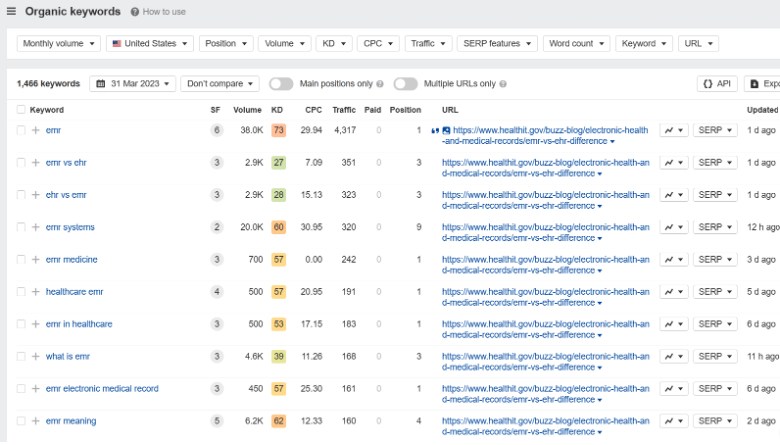How to Build a Content Marketing Keyword Plan (+ Ahrefs Tutorial)

TL;DR: Building a keyword strategy is crucial to your content marketing efforts. It helps boost your online visibility, attract a more targeted audience, stay competitive in the market, and also enables you to measure your success.
So What: A well-structured keyword plan ensures search engines understand your content. It also helps align the content with your target audience’s needs and interests. The keyword plan further enhances your search engine optimization (SEO) efforts by boosting the visibility of your website in SERPs.
Before you follow along with this guide, make sure to download our Keyword Planning Sheet.
How to Use Our Keyword Planning Assistant
Just enter an initial keyword (or list of keywords), and our AI-powered tool will generate your Golden Keywords based on the two most important metrics: quantity and quality.
- Quantity is the estimated number of searches per month;
- Quality is the estimated Cost Per Click (CPC), or what Google advertisers are willing to pay per click.
We multiply these two metrics — quality times quantity — to get a “total dollar amount,” or the amount of marketing money that’s spent on that keyword each month in Google.
This is a much better way of identifying keywords, as we’ll explain below. But first, try out the tool!
Our Two Keyword Metrics
At Media Shower, we invented SEO.
Our approach to SEO keywords includes just two basic measurements:
- The number of searches per month
- The cost per click is the amount people are willing to pay to advertise that keyword on Google.
That’s it. No “keyword difficulty,” no “competitor research,” no “clicks per month.” Just searches and CPC.
The number of searches represents the quantity in your ROI calculation, and the cost per click represents the quality. Good keywords, like good content, need both quantity and quality. Your job is to find the sweet spot between the two.
When we multiply these numbers together, we get what we call opportunity:
Number of Searches Per Month x Cost Per Click = Opportunity
The opportunity is how much money is spent in Google monthly on a specific keyword. It’s a way to compare all your keywords, apples-to-apples. Consider it: “How many marketing dollars are spent on this keyword in Google monthly?”
To summarize: Quantity (keyword volume) x quality (CPC) = Opportunity.
How to Perform Competitor Research Using Ahrefs
Ahrefs is our preferred choice for finding your “golden keywords.” It’s also a great way to see what keywords your competitors own so you can slowly start winning market share. To perform competitor research using Ahrefs, first perform a Google search on the topic(s) you want to rank for.
Let’s say you’re a medical services provider and want to create a blog or page on EMRs (electronic medical records), which is your broad topic. First, do a Google search on “medical EMR” to see what pops up.
When you find a high-ranking site that discusses this subject, copy the URL and paste it into the domain bar at the top of Ahrefs:

Competitor Analysis
Once you get the results, you’ll want to see which keywords your competitor is ranking for. To do this, click “Organic keywords” on the left-hand side as shown below. You’ll be taken to another page showing which keywords (and how many) each competitor ranks for.

Some of these sites (like the one we’re analyzing for this blog) will rank for several, meaning you’ll have to narrow your list down (as mentioned before, we recommend no more than 100 terms).

We recommend that you run this process with a few separate pages ranking near the top on the first page of Google, leading to several overlapping keywords you’ll want to focus on.
Exporting Your Data
After the keyword list is presented, hit “Export” in the upper right-hand corner:

This will open a separate window confirming the keywords will be sent to a downloadable Excel spreadsheet. Click “Export” at the bottom:

Keyword Audit and Technical Analysis
Once you’ve downloaded all the keywords into an Excel sheet, you can get rid of ones that aren’t relevant while keeping those that best serve you. Your keyword analysis could end here if you find enough valid keywords. However, for those who wish to take things a step further, consider the next (optional) step:
Click the “Keywords Explorer” tab at the top of Ahrefs:

The goal is to see if additional or secondary keywords rank alongside your initial choices. Take your top five terms and place them in the open space. Then click the orange magnifying glass in the bottom right corner to proceed with a keyword analysis:

Once the next page loads, click “Search suggestions” on the left:

This will take you to a new list of keywords suggested by Ahrefs based on the terms you entered previously. Some will be outlandish, but you’ll also find some hidden gems.
Lastly, you can list all your selected keywords in the Media Shower Content Marketing Keyword Planner.

Our spreadsheet will format all this keyword data into the simple metrics we discussed above: Searches per Month (quantity), CPC (quality), and Monthly Opportunity (quantity x quality).
How to Trim Your List to the Top 10 Keywords
The final step in your content marketing ROI plan is to create a list of your top ten keywords. No more, no less. Your content “tentpoles” will include these keywords, and all your content will be built around the top terms, adding in others from the list as it makes sense.
From this list of the best possible keywords, you can create a content roadmap outlining specific blog posts, downloadables, and videos to push search traffic toward your site and convert that traffic into leads through compelling calls to action (CTAs).
Media Shower Best Practices
Over the years, we’ve tweaked and refined our SEO strategy with hundreds of clients. Now, you can download our Content Marketing Keyword Planning tool, the same template we use for clients. Read on to see how it works, then download it for free.
The video walks you through how to use the template step-by-step.
An effective keyword plan is the core of any successful content marketing efforts. Keywords are the voice of your customers, and you should design them to respond to the exact customer queries and intentions.
The general rule is to adopt the KISS principle: Keep It Simple, SEO. This means keeping your list of keywords simple along with your selection criteria. By keeping SEO simple and breaking it down into just a few key components, it’s possible to determine return on investment (ROI).
In short, we want a laser-targeted list of keywords to generate the most qualified sales leads. Leads, in the end, are what we’re after. As online marketers, that’s our job. Here are some practical tips to help you achieve that:
Define Your Goals
Before diving into keyword research, it’s crucial to define your goals. What do you hope to achieve with your content marketing strategy? Understanding your goals will guide your keyword selection and help you measure your success.
Do they want to:
- Increase brand awareness: Target keywords related to your industry and brand identity.
- Generate leads: Focus on keywords indicating purchase intent or information-seeking behavior.
- Boost sales: Prioritize keywords associated with product features and benefits.
- Improve website traffic: Target high-volume, relevant keywords with lower competition.
Identify Your Target Audience
The more you know about your target audience, the better you can tailor your keyword choices to resonate with them.
Understand your audience by their:
- Demographics: Age, location, income, etc.
- Needs and pain points: What problems do they face?
- Interests and online behavior: What questions do they search for?
- Preferred content formats: Videos, articles, infographics, etc.
Understand Search Intent
Go beyond the terms themselves and analyze the underlying intent behind user searches. Are they looking for information, comparison, purchase, or something else?
Consider the following:
- Analyze the “why” behind the search: Don’t just see keywords as phrases, but ask questions like “What problem are they trying to solve?” or “What information are they hoping to find?”
- Identify user journey stages: Differentiate between informational (“best vegan protein powder”) and transactional (“buy vegan protein powder”) searches to tailor your content accordingly.
- Use SERP analysis: Study top-ranking content for your target keywords to understand how search engines interpret intent and what resonates with users.
Consider Long-Tail Keywords
While high-volume keywords can be enticing, don’t overlook long-tail variations. Long tail keywords are more specific, offering lower competition, higher conversion rates, and deeper insights into specific user needs.
Here are a few things to consider:
- Identify long-tail variations: Use keyword research tools and competitor analysis to uncover long-tail variations with high relevance and lower competition.
- Go beyond “best”: Don’t just focus on “best X” keywords. Explore specific needs and preferences (e.g., “affordable vegan running shoes for wide feet”).
- Craft targeted content: Create content directly addressing the issues and questions in long-tail keywords.
- Track conversion rates: Monitor which long-tail keywords drive the most valuable conversions (e.g., leads, sales) and prioritize them in your strategy.
Embrace Local Search
If your business has a local presence, optimize for local keywords with geographic modifiers. Include your city, neighborhood, or specific service areas to attract nearby customers searching for solutions in your locality.
Consider the following:
- Target local searches: Integrate city, neighborhood, or service area names into keywords (e.g., “best dog walker in Seattle”).
- Optimize local listings: Secure your presence on Google My Business and other local directories.
- Showcase your local expertise: Highlight local offerings, events, and community engagement in your content.
Click to access our Content Marketing Keyword Planner sheet and start establishing your keyword SEO dominance today!


